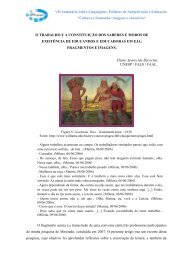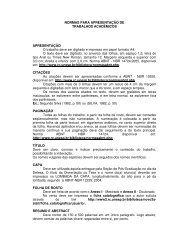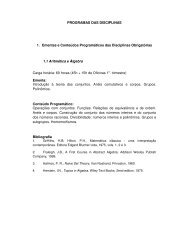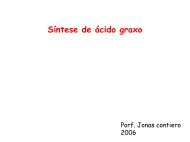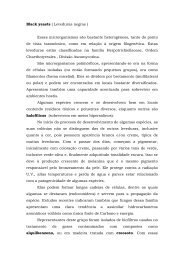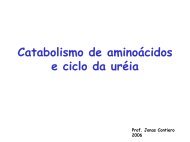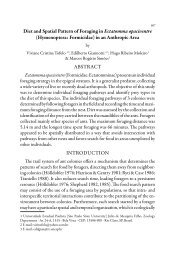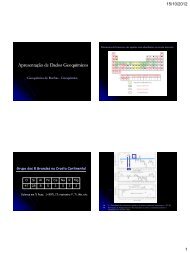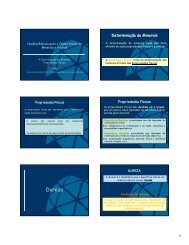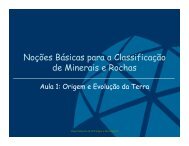You also want an ePaper? Increase the reach of your titles
YUMPU automatically turns print PDFs into web optimized ePapers that Google loves.
II Encontro dos Programas de Pós-Graduação em Geociências, 2008<br />
PERMIAN PETRIFIED FERTILE FERN LEAVES FROM THE CENTRAL<br />
NORTH BRAZIL (PARNAIBA BASIN, ARAGUAINA REGION,<br />
MARRATIALLES)<br />
TATIANE MARINHO VIEIRA TAVARES<br />
E-mail: tatipaleo@yahoo.com.br<br />
Orientador: Prof. Dr. Rosemarie Rohn<br />
The Natural Monument of Petrified Trees in Tocantin, Central North Brazil, is mainly<br />
characterized by the abundant well preserved tree fern stems (mainly Tietea and<br />
Psaronius), rare other ferns (Grammatopteris, Dernbachia), as well as gymnosperms<br />
(“Dadoxylon” and others). They occur in the southern margin of the Parnaíba Basin in<br />
fluvial fine sandstones and siltstones, probably of the Motuca Formation, tentatively<br />
positioned close to the Lower-Middle Permian boundary. The Buritirana Farm in the<br />
Monument additionally has provided outstanding pinnae preserved as petrifactions.<br />
Rare specimens may be included in the compression taxa Pecopteris, Sphenopteris and<br />
Lobatopteris, but the majority corresponds to very peculiar ferns of the Scolecopteris<br />
type. Their most intriguing characteristic is the pectinate pinnule margin with lobe<br />
sinuses very close to the midvein at the adaxial surface and narrow linear lobules curled<br />
under, reaching the midvein on the abaxial surface. The lobule lamina is relatively thick.<br />
Tangential sections of pinnules show a decurrent strong secondary vein at the middle of<br />
each lobule. In some specimens, the lobules were removed from the abaxial surface and<br />
the synangia are exposed in 3D. The synangia are borne in one row on each side of the<br />
pinnule midrib, disposed very closely, with pedicel apparently attached to the midrib.<br />
The shape is broadly oval, slightly acute at the distal part. They are composed of 3 or 4<br />
axially elongate sporangia, fused laterally, not well radially symmetrical. The pinnules<br />
are oblong, with rounded tips, closely spaced, attached at 90 o to the pinna rachis, which<br />
shows distinct trichomes and a W-shaped vascular trace. Scolecopteris species from the<br />
Permo-Carboniferous of Euramerica, Cathaysia and Triassic in Antarctica show<br />
pecopterid foliage with smooth to slightly lobed margins, or their shape cannot be<br />
determined in sections, being not taken into consideration for classification. The only<br />
apparently similar other fertile pectinate pinnules were observed in the Middle Permian<br />
of the Paraná Basin, southern Brazil, where Tietea and Psaronius also occur. Up to the<br />
moment, it was not possible to substantiate whether the fertile pinnae from both the<br />
Parnaíba and Paraná basins are related to Tietea, but their apparent restriction to<br />
Western Gondwana is significant. The ecological reason for the deep incisions at the<br />
pinnule margins must be further investigated, considering that thick leaf laminae and<br />
inrolled margins to the abaxial side may indicate a protection from dehydration.<br />
Palavras-chave: Permian, Marattiales, Scolecopteris, Parnaiba Basin.<br />
Dados acadêmicos: Nível: Doutorado; Título do Projeto: Estudo de Psaroniales da<br />
porcao setentrional de Tocantins, na Bacia do Parnaiba (Permiano, Brasil); Linha de<br />
pesquisa: Bacias sedimentares e seus recursos (hídricos e energéticos); data de entrada<br />
91




